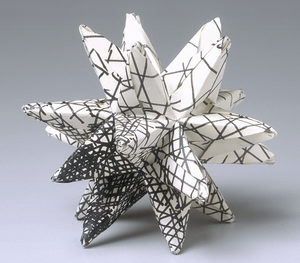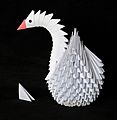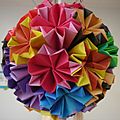Modular origami facts for kids
Modular origami (also called unit origami) is a cool type of paper folding. It uses lots of paper pieces to make big shapes you can't make with just one piece of paper. You fold many pieces of paper into the same shape. Then, you put them together by fitting flaps into little pockets.
Contents
History of Modular Origami
The first known modular origami model appeared in a Japanese book from 1734. This book, called Ranma Zushiki, showed many traditional origami models. One of them was a modular cube called tamatebako.
Tamatebako means "magic treasure box" in Japanese. It got this name because you could open the box from any side. Another old model is the kusudama. These are balls made from folded paper flowers. People often hang them up as decorations using string or thread.
What Are Origami Modules?
In modular origami, the folded paper pieces are called "modules." You can use anywhere from two to thousands of these modules to build a model. They usually stay together just by the friction of the paper. Sometimes, people use glue or thread to make them stronger.
The Famous Sonobe Module
Mitsunobu Sonobe designed a very popular module in the 1970s. It's called the Sonobe module. It is so simple that many people can make kusudamas with it. The Sonobe module is one of the most famous modules in origami. You can put many of these modules together to create shapes like cubes or other cool geometric forms.
How Easy Is It to Connect Modules?
"Modular Rate" is a way to describe how easy it is to put modules together. It measures how many people can connect the pieces without using glue or other joining materials. This idea applies to models designed to fit together perfectly without extra help.
Images for kids
See also
 In Spanish: Origami modular para niños
In Spanish: Origami modular para niños






